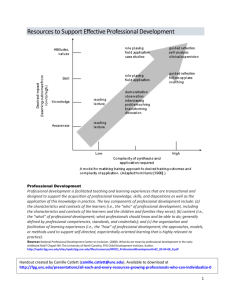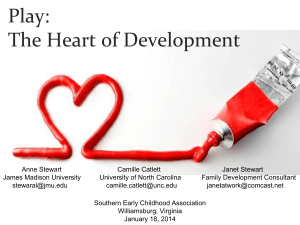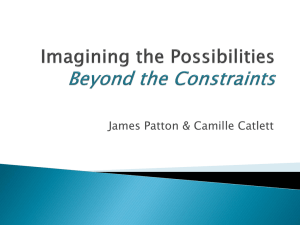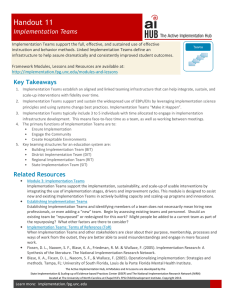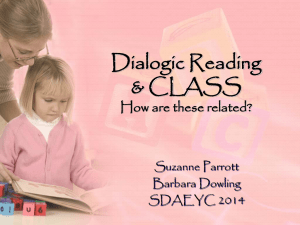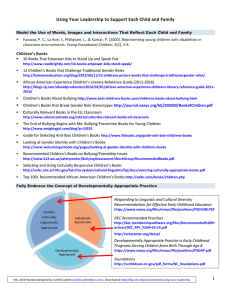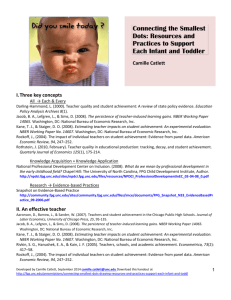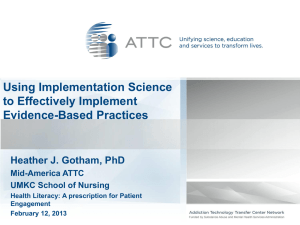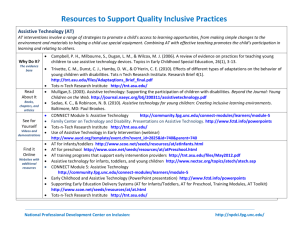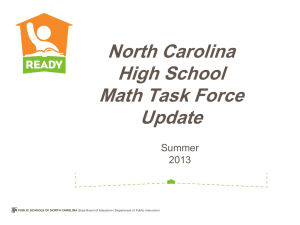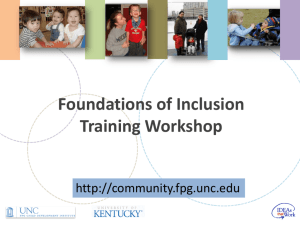Good better best handout - FPG Child Development Institute
advertisement
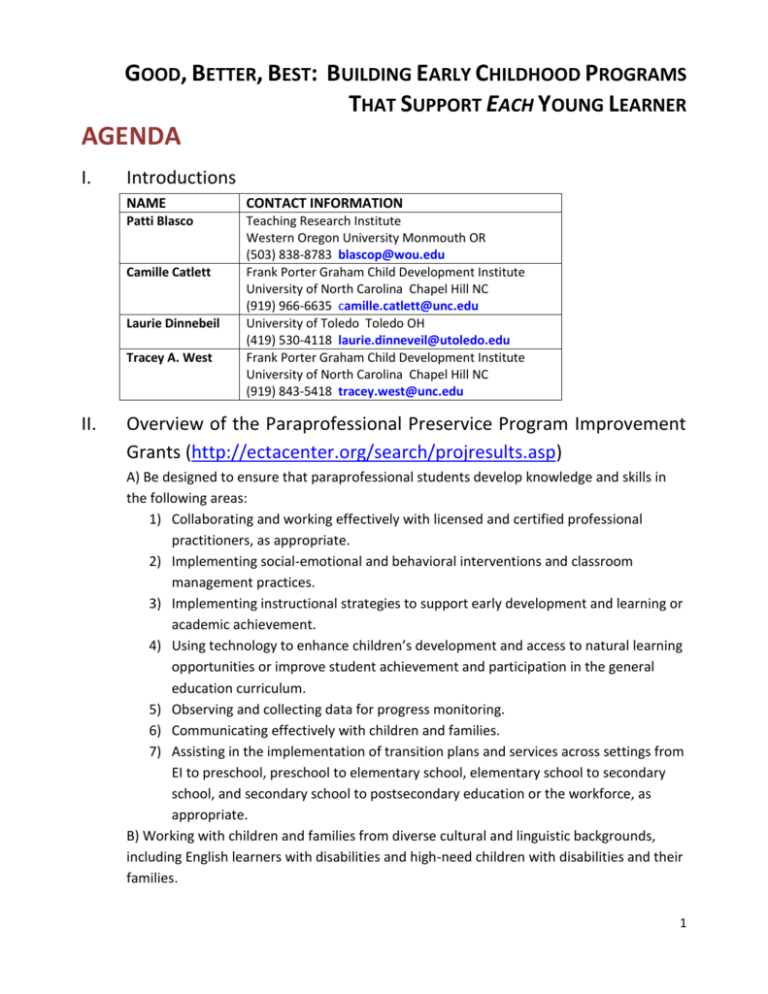
GOOD, BETTER, BEST: BUILDING EARLY CHILDHOOD PROGRAMS THAT SUPPORT EACH YOUNG LEARNER AGENDA I. Introductions NAME CONTACT INFORMATION Patti Blasco Teaching Research Institute Western Oregon University Monmouth OR (503) 838-8783 blascop@wou.edu Frank Porter Graham Child Development Institute University of North Carolina Chapel Hill NC (919) 966-6635 camille.catlett@unc.edu University of Toledo Toledo OH (419) 530-4118 laurie.dinneveil@utoledo.edu Frank Porter Graham Child Development Institute University of North Carolina Chapel Hill NC (919) 843-5418 tracey.west@unc.edu Camille Catlett Laurie Dinnebeil Tracey A. West II. Overview of the Paraprofessional Preservice Program Improvement Grants (http://ectacenter.org/search/projresults.asp) A) Be designed to ensure that paraprofessional students develop knowledge and skills in the following areas: 1) Collaborating and working effectively with licensed and certified professional practitioners, as appropriate. 2) Implementing social-emotional and behavioral interventions and classroom management practices. 3) Implementing instructional strategies to support early development and learning or academic achievement. 4) Using technology to enhance children’s development and access to natural learning opportunities or improve student achievement and participation in the general education curriculum. 5) Observing and collecting data for progress monitoring. 6) Communicating effectively with children and families. 7) Assisting in the implementation of transition plans and services across settings from EI to preschool, preschool to elementary school, elementary school to secondary school, and secondary school to postsecondary education or the workforce, as appropriate. B) Working with children and families from diverse cultural and linguistic backgrounds, including English learners with disabilities and high-need children with disabilities and their families. 1 C) Be designed to include field-based preservice preparation opportunities in high-need LEAs, high–poverty schools, or low-performing schools, including the persistently lowestachieving schools. III. Lessons Learned About Associate Degree Programs IV. Articulation Difference between knowledge and application to coursework Preparing ECE professionals for a variety of positions Workload of community college faculty members Resources (or lack thereof) available to community college faculty members The nature of the student population and its impact on program participation and completion Lessons Learned About Getting Explicit and Intentional Make sure that every component of the course syllabus is aligned and consistent with goals and objectives of the course Be specific about course assignments—make sure that they reflect the course goals and objectives Instead of adding new goals and objectives to a course, embed EI/ECSE content into course components Don’t assume that all students follow a specific sequence in program completion Many faculty members report a solid understanding of content related to EI/ECSE However, these faculty members also report difficulty finding and embedding resources related to that content V. Lessons Learned About Resources VI. So What’s Changed? a. Course syllabi have better alignment across components b. The program better addresses critical course content related to EI/ECSE c. Course assignments are more specific and better assess students’ knowledge and skills related to EI/ECSE content VII. Discussion This handout may be downloaded at http://fpg.unc.edu/presentations/good-better-best-buildingearly-childhood-programs-support-each-young-learner-0 2 Getting Explicit and Intentional Step Considerations Examine sequence of field experiences Provide a sequence of professional development to support changes in content and process Identify priorities for change and deconstruct/reconstruct courses to intentionally reflect priorities: The priorities of SCRIPT-NC include incorporating evidence-based practices that support children and families who are culturally, linguistically, and ability diverse (CLAD). Establish the Who takes this course? Where does it fall in the sequence of the context for the program? course Describe the gist What are the major concepts students should take away from this of the course course? Review the course Does the course title match the gist? title and Does the course description match the gist? description Do the course title and description match the values for CLAD? Review the Do the objectives/outcomes match the gist? objectives/ Do the objectives/outcomes reflect the values for CLAD? learning outcomes Are the objectives/outcomes measurable? Are they reasonable? Review the Do the assignments provide opportunities to measure achievement of assignments each learning objective/outcome? Do the assignments incorporate opportunities for both knowledge acquisition and knowledge application? Do any of them presume prior knowledge or experience? Do the assignments occur in a logical sequence? Do the assignments match the gist? Reflect the values for CLAD? Instructional Does the sequence of instruction flow logically? sequence and Do the instructional resources (activities, readings, handouts, guest resources speakers) consistently reflect program values for CLAD? If there is a text, does it support the objectives/outcomes and the values? Are field experiences thoughtfully aligned with course experiences to promote discussion, reflection, and evidence-based practices? Examine overall Are there gaps in content not covered by any courses? instructional Is there unnecessary overlap between courses? sequence What is the sequence and scope of the experiences? Are a variety of experiences provided? Adapted from work by Crosswalks, Camille Catlett (2013) and SCRIPT-NC (2013) 3 RESOURCES TO SUPPORT THE PROCESS CONNECT Modules http://community.fpg.unc.edu/connect-modules Overview of CONNECT http://community.fpg.unc.edu/connect-modules/resources/videos/CONNECT-Video-Ad CONNECT Resource Library http://community.fpg.unc.edu/connect-modules/resources CONNECT Instructor Supports http://community.fpg.unc.edu/connect-modules/instructor-supports CONNECT Modules for Instructors http://community.fpg.unc.edu/connect-modules/instructor-community Early Childhood Learning and Knowledge Center http://eclkc.ohs.acf.hhs.gov/hslc National Center on Cultural and Linguistic Responsiveness http://eclkc.ohs.acf.hhs.gov/hslc/tta-system/cultural-linguistic National Center on Quality Teaching and Learning http://eclkc.ohs.acf.hhs.gov/hslc/tta-system/teaching/Disabilities 15 Minute In-Services (expansions, asking questions, engaging children in conversations) http://eclkc.ohs.acf.hhs.gov/hslc/tta-system/teaching/center/practice/ISS/ISS-library_T.html National Professional Development Center on Inclusion http://npdci.fpg.unc.edu/ DEC/NAEYC. (2009). Early childhood inclusion: A joint position statement of the Division for Early Childhood (DEC) and the National Association for the Education of Young Children (NAEYC). Chapel Hill: The University of North Carolina, FPG Child Development Institute. http://npdci.fpg.unc.edu/resources/articles/Early_Childhood_Inclusion Research synthesis points on practices that support inclusion. Chapel Hill: The University of North Carolina, FPG Child Development Institute, Author. http://npdci.fpg.unc.edu/sites/npdci.fpg.unc.edu/files/resources/NPDCIResearchSynthesisPointsInclusivePractices-2011_0.pdf Evidence-based practice landing pads http://npdci.fpg.unc.edu/resources/quality-inclusive-practices-resources-and-landing-pads Paraprofessional Preservice Program Improvement Grant Websites Heartland Equity and Inclusion Project http://www.hcc.cc.il.us/heip/ Kirkwood Community College curriculum maps http://www.kirkwood.edu/site/index.php?p=33656 The Partner Project o http://m.utoledo.edu/healthsciences/grants/partnerproject/ o http://www.youtube.com/channel/UCpLcAeRH3HTInvMhjbVpBxQ Preparing Early Childhood Professionals for Inclusion http://www.centeroninclusion.org/PEPI/PEPIenhancements.htm SCRIPT-NC http://scriptnc.fpg.unc.edu o Landing Pads http://scriptnc.fpg.unc.edu/resource-search Video Libraries Results Matter video library http://www.cde.state.co.us/resultsmatter/RMVideoSeries_EarlyIntervention.htm#top University of Northern Iowa Empowering Preschool Quality o http://www.uni.edu/coe/regentsctr/epq/search (to view clips online) o http://www.uni.edu/coe/regentsctr/epq/dvd-order-form (to order free DVDs) Video Library http://www.ecetp.pdp.albany.edu/videolibrary.shtm 4
